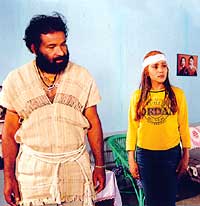 There are Bollywood-type melodramatic tearjerkers, and there are movies like Tulsi Ghimirey's Dui Kinara, which are just so pure in their sentiments that they bring tears to your eyes.
There are Bollywood-type melodramatic tearjerkers, and there are movies like Tulsi Ghimirey's Dui Kinara, which are just so pure in their sentiments that they bring tears to your eyes. It is a love story in which a young fisherman falls in love with a Nepali woman raised in America while she's on a visit home. He thinks this is such an impossible relationship that he doesn't let his feelings show. But he is attached to her son, and.I shouldn't give away too much of the plot.
There isn't anything extraordinary about the plot, indeed it is the simplicity of the story and the Nepali touch that is the most moving. Bhupen Chand, Niruta Singh and even child actor Siddhanta Ghimirey provide stellar performances. After a recent premier of the three-hour movie, I went up to Bhupen Chand and congratulated him. Chand didn't want to follow his father into politics and trained to be a pilot. But it is in film that he seems to have found his true calling. Chand must have seen my moist eyes and asked:
"Did you cry?" I told him I did, not once but twice.
 Tulsi Ghimirey said in a BBC interview three years ago: "The Nepali audience wants drama with a good social message." It looks like Ghimirey has delivered exactly that with Dui Kinara. In the interview the veteran director also said: "We shouldn't give up, and we must compete with Indian films differently not with bigger budgets but with relevance and Nepaliness."
Tulsi Ghimirey said in a BBC interview three years ago: "The Nepali audience wants drama with a good social message." It looks like Ghimirey has delivered exactly that with Dui Kinara. In the interview the veteran director also said: "We shouldn't give up, and we must compete with Indian films differently not with bigger budgets but with relevance and Nepaliness." That was a time Ghimirey's Darpan Chhayan was drawing unexpected crowds and raked in more than Rs 30 million at the box office. More than half the theatres across the country, including those in the tarai belt, were showing Nepali films. Fifty Nepali movies were being produced every year and they were doing well despite the world's largest film industry being right next door. The logic that Nepali audiences would not respond to Nepali movies was proved a fallacy.
But things started going wrong. As the security situation deteriorated and the state of emergency was declared in 2001, the cinema industry took a direct hit. Anywhere else, the film industry would have done well in times of crisis. After all, celluloid is a form of escapism. Here, the public was reluctant to go to the movies because of security concerns. But that still doesn't explain full houses in a South Asian documentary film festival last year, and Kathmandu's youth don't seem to be scared to attend concerts, and the discos and dance clubs in Thamel are full till late at night.
Actor Hari Bansha Acharya doesn't believe security concerns are the main reason for the downturn in the cinema industry. He argues that the people who used to go to the movies prior to the state of emergency simply aren't in Nepal anymore, having left for the Gulf or for Malaysia. In order to attract an audience, Acharya thinks Nepali directors and producers need to pay serious attention to quality.
During a talk program last month at the Reporters' Club, actress Jal Shah publicly admitted she felt ashamed being a cinema actress. Is this why educated parents tend to discourage children from joining the film industry? What is the main reason Nepalis don't watch Nepali molvies anymore? Who is to blame: the directors, producers, actors, the government, the Film Development Board?
All of the above, says Tulsi Ghimirey. "Times are difficult, the industry is going through a serious crisis. There is nothing negative about it, there are ups and downs in every industry. People do want to watch good movies," he says.
And that is exactly what he seems to have done with Dui Kinara, blending a powerful story with good acting and professional production. The success of Numafung and the documentary Bhedako Oon Jasto must mean that times are changing, and so is public taste.


